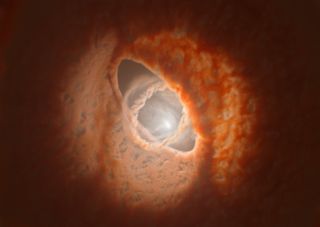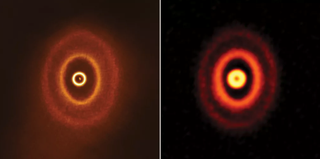Exceptionally rare planet with three suns may lurk in Orion's nose
A Jupiter-sized world may be kicking up dust in the triple-star system GW Ori.

There's now even more evidence that a bizarre star system perched on the constellation Orion's nose may contain the rarest type of planet in the known universe: a single world orbiting three suns simultaneously.
The star system, known as GW Orionis (or GW Ori) and located about 1,300 light-years from Earth, makes a tempting target for study; with three dusty, orange rings nested inside one another, the system literally looks like a giant bull's-eye in the sky. At the center of that bull's-eye live three stars — two locked in a tight binary orbit with each other, and a third swirling widely around the other two.
Triple-star systems are rare in the cosmos, but GW Ori gets even weirder the closer astronomers look. In a 2020 paper published in The Astrophysical Journal Letters, researchers took a close look at GW Ori with the Atacama Large Millimeter/submillimeter Array (ALMA) telescope in Chile, and discovered that the system's three dust rings are actually misaligned with one another, with the innermost ring wobbling wildly in its orbit.

The team proposed that a young planet, or the makings of one, could be throwing off the gravitational balance of GW Ori's intricate triple-ring arrangement. If the detection is confirmed, it would be the first triple-sun planet (or "circumtriple" planet ) in the known universe. Eat your heart out, Tatooine!
Now, a paper published Sept. 17 in the journal Monthly Notices of the Royal Astronomical Society offers fresh evidence of that rare planet's existence. The study authors conducted 3D simulations to model how the mysterious gaps in the star system's rings could have formed, based on observations of other dust rings (or "protoplanetary disks") elsewhere in the universe.
The team tested two hypotheses: Either the break in GW Ori's rings formed from the torque applied by the three twirling stars at the system's center, or the break appeared when a planet formed within one of the rings.
The researchers concluded that there is not enough turbulence in the rings for the stellar torque theory to work. Rather, the models suggest that the presence of an enormous, Jupiter-size planet — or perhaps several planets — is the likelier explanation for the rings' strange shape and behavior.
Sign up for the Live Science daily newsletter now
Get the world’s most fascinating discoveries delivered straight to your inbox.
If future observations of the system support that theory, GW Ori may be "the first evidence of a circumtriple planet carving a gap in real time," lead study author Jeremy Smallwood, from the University of Nevada, Las Vegas, told The New York Times.
Sadly, a hypothetical observer of this maybe-planet wouldn't actually be able to see all three suns rise and fall in the sky; the two stars at the center of the system move in such a tight binary orbit that they would appear as one great star, with the third swooping around them, the researchers said.
But, if confirmed, the mere existence of this world would prove that planets can form under a wider array of conditions than scientists previously realized. If three suns and a wobbling mish-mash of dust rings aren't enough to thwart a fledgling planet, then who knows what is.
Originally published on Live Science.

Brandon is the space/physics editor at Live Science. His writing has appeared in The Washington Post, Reader's Digest, CBS.com, the Richard Dawkins Foundation website and other outlets. He holds a bachelor's degree in creative writing from the University of Arizona, with minors in journalism and media arts. He enjoys writing most about space, geoscience and the mysteries of the universe.
Most Popular


